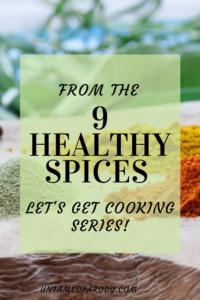
Spices have been used in Ayurvedic medicine in India and traditional Chinese medicine (TCM) in China for more than 5,000 years. There are 9 spices that may have health benefits, based on this ancient medicine.
Note: the following is not endorsed by any physician, nor by this writer. All content is based on publicly accessible content. Please consult with your personal physician regarding the use of spices for health and healing.
Most often, I hear of people turning to spices to aid in digestion. Good digestion and gut health can boost the immune system. Some spices may also offer pain relief from arthritis and chronic pain. Let’s look at a few of the top spices in Mother Nature’s medicine cabinet. Note that with the exception of the first one, most of these can be eaten fresh rather than dried so you don’t lose any nutrients.
Should you decide, with the guidance of your health professional, to add spices to your diet specifically for health benefit, remember that many of the come in health supplement/capsule form. When using in cooking, note that dried herbs and spices can be three to seven times more concentrated in flavor than fresh. Add a little to start with when you’re learning how to cook with them, and then use more if needed.
Cayenne
This spice comes from the pepper family and also offers a warming quality and pain relief. Many creams used for arthritis contain active ingredients found in this pepper, capsaicin. It may also good for blood circulation
Turmeric
Beautiful bright yellow, this root is powdered into a spice that has a warming quality and may great for both digestion and pain relief. It is ideal in rice and chicken dishes and is one of the bases for curry powder.
Ginger
Ginger is a tasty root that can be used in sweet and savory recipes. It is a staple of Indian and Chinese food and is used for digestion and pain relief. Some believe there are benefits for skin conditions such as acne and eczema. It may also good for blood circulation.
Licorice Root
This root might be used to regulate blood sugar and the hormone cortisol, which is associated with the ability to lose weight. It may aid healthy digestion and can be a tasty treat for those who like black licorice.
Milk Thistle
This may aid in overall digestion and is believed to be a liver detoxifier that relieves liver inflammation. The liver plays an important role in filtering harmful substances out of the body.
Peppermint
Peppermint is another tasty spice used to aid digestion. If you’ve ever been offered a mint after a meal, you’ve probably experienced its stomach-soothing properties. It is generally considered safe as long as it is not consumed in large doses. I personally use peppermint essential oils to relieve congestion from allergies or a cold. I do not put peppermint directly on my skin as it has a drying effect. Try it! Mix a few drops in a carrier oil, such as avocado oil, and dab under your nose. Works great!
Cardamom
Cardamom pods are often used whole in Indian recipes. The little black seeds inside are ground up for Indian food, and for Scandinavian baked goods. It is believed to ease heartburn and may offer relief for irritable bowel syndrome (IBS). It may also encourage digestive enzyme secretion, so the food you eat is broken down more efficiently and the nutrients absorbed more rapidly.
Coriander
Coriander seeds and leaves are both used in Indian and Thai food, as well as in Mexican food (known as “cilantro”). It has a pungent flavor and is full of healthful fatty acids. It is good for soothing the stomach and also has a lot of fiber which may help with bowel health.
Cumin
Cumin is often paired with coriander in the same cuisines. It may aid in digestion and encourage the secretion of digestive enzymes. It is also high in fiber.
Do you use spices as part of your overall health routine? Let us know how by commenting below!
